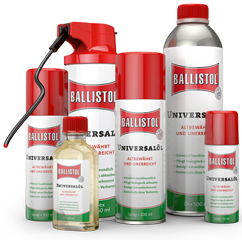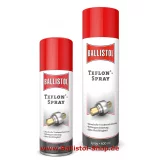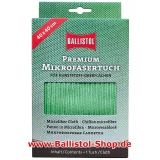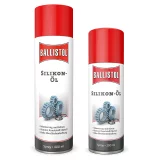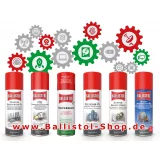Silicone oil
- Manufacturer: Ballistol
- Immediately ready for shipping
Delivery time 1 - 3 days inside Germany (further)- for deliveries abroad to the EU, Switzerland (CH) or Luxembourg (LU) within 3 - 5 days
- for all other foreign deliveries within 7 - 14 days
- Datasheet: show
Sliding-scale prices: from 4,14 EUR to 146,52 EUR
- 65 ml
- 3
- 4,36 EUR
- 6
- 4,30 EUR
- 12
- 4,24 EUR
- 18
- 4,18 EUR
- 24
- 4,14 EUR
- 5 liter
- 3
- 146,52 EUR
- 10
- 143,09 EUR
-
- 65 ml
- 4,49 EUR*(Groundprice: 69,08 EUR pro Liter)
- Product No.: 25331 / EAN: 4017777253313
-
- 5 liter
- 149,95 EUR*(Groundprice: 29,99 EUR pro Liter)
- Product No.: 25910 / EAN: 4017777259100
- available soon

Silicone oil
Silicone oil is a lubricant without mineral oil. It is based on the natural mineral silicon. Silicone oil has many advantages compared to petroleum-based oils. It is primarily used for lubrication and care (especially of plastics and rubber), as well as as a release agent and for insulation, for example of electrical circuits. It is also used for wood, leather and artificial leather as well as for metal, glass, textiles and many other materials. It leaves no stains and is more compatible with materials than almost any other lubricant. This means that silicone oil can lubricate and protect invisibly.
Silicone oil is very easy and effective to use. The effects such as lubrication, protection, insulation, etc. are available immediately and for a long time. Silicone oil is therefore often used as a universal care product.
Unlike minerals, no fossil raw materials are required to produce silicone oil. The natural mineral silicon occurs everywhere in nature.
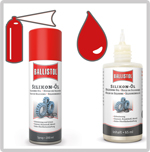
Silicone oil or silicone spray?
When do you use the dropper bottle with liquid oil and when is spray more suitable? The answer is quite simple: Whenever you need to be precise or precise, the dropper bottle is the best choice. If you want to apply the silicone oil evenly and flatly, use the Silicone Spray.
Properties of silicone oil
Silicone oil is odorless, colorless and non-toxic. It does not stick and is extremely capable of creeping due to the low surface tension.
Silicone is temperature-resistant even with strong fluctuations from approx. -50 °C to +200 °C. Our silicone oil has a viscosity of 85 (kinematic) at 20 °C. With this low viscosity it is a nice thin lubricant.
It is often used in the food environment. Bread slicers, coffee machines and other kitchen appliances are best treated exclusively with silicone oil. If a manufacturer wants to label their silicone oil as food-safe, a very expensive approval is required. At Ballistol, H1 food oil has this approval. But Ballistol silicone oil is also non-toxic, odorless, tasteless and physiologically/biologically neutral.
The silicone oil is non-flammable. The density at 20 °C is 0.96 g per cm3. Vapor pressure and boiling point have not been specifically determined. In general, silicone oils have a boiling point of over 200 °C. As can be seen from the data sheet, the surface tension is also not determined. However, silicone oils have a particularly low surface tension. That's why it's an outstandingly good penetrating oil. At 25 °C a surface tension of approx. 21.5 mN/m can be assumed.
Silicone oil for acrylic pouring

Acrylic pouring is a popular fluid art technique for pouring acrylic paintings. With this technique, acrylic paints are used in the flow technique to create surprising creations that cannot be planned in detail. The perfect counterpart to acrylic is silicone. Silicone creates bubbles, the bubbles popular with acrylic pouring cannot be created so beautifully and easily with any alternative to silicone oil. Ballistol silicone oil has become one of the most popular silicone oils for acrylic pouring with its low viscosity and dropper bottle.
Convincingly beautiful, quick effects can be created when painting with acrylic paints. What is desirable in painting is a „horror“ in the paint shop. Silicone must not be present in small quantities in a car paint booth because bubbles are not wanted here.
Is there a substitute for silicone oil?
No other oil or medium creates such impressive cells or bubbles as silicone oil in acrylic paints. Therefore, there is no alternative to silicone oil in the area of acrylic pouring. But no alternative is necessary. Because there are no disadvantages of silicone oil when dealing with acrylic paints or especially with the acrylic pouring technique.
This is how to use silicone oil for acrylic pouring
Simply mix the acrylic paints as usual and add one or two drops of silicone oil. Stir again and pour the acrylic paints as usual. Now you can observe the formation of the bubbles.
In the video you can see how the oil creates perfect cells:
Silicone oil for treadmill
For the regular care and lubrication of treadmills, only silicone oil is used. The treadmill runs easily and evenly thanks to the silicone oil. This ensures that the motor does not overheat and the treadmill does not wear out if there is too much friction. If you use the treadmill regularly, you should treat it every one to two months.
How to properly lubricate the treadmill
The silicone oil is applied to the treadmill from below. Depending on the model, you can get by with a dropper bottle. You can also spray the silicone oil under the treadmill. To do this, use silicone spray.
The silicone oil must at least moisten the areas where the treadmill runs over the rollers or rollers. You don't have to be fussy about wetting the entire surface, as the oil spreads itself as you walk.
Once the silicone oil is applied, run the treadmill slowly – up to approx. 5 km/h. After about three minutes, you can help distribute the silicone by walking on the belt.
If you accidentally apply too much, you can rub off the excess with a dry, lint-free cloth.
Other areas of application for silicone oil
- In the automotive sector, silicone oil is often used for the lubrication of sunroofs and guides. Seat rails, joints, etc. used.
- In industry it is used as a release agent when casting or as an assembly aid for hoses, pipes, O-rings and fittings.
- It is also used to prevent adhesions and to improve sliding activity.
- In paper processing and wood processing it prevents residues of paper, wood or adhesives from sticking to the presses and machines. Cutting tools and cutting edges are also treated with it to enable easy cutting and a clean result.
- In Logistics it is used to increase the sliding properties of conveyor belts and thus prevent the goods being transported from sticking.
- Rubber seals, plastic gears, plastic gears, slide rails, rollers, cables, window seals, etc. can be professionally but very easily maintained with silicone oil.
- It is also ideal as a release agent for mold making.
- Silicone oil in model making
In model making and the RC hobby, silicone oil is used in many ways and not just as a lubricant. In addition to the care and lubrication of plastic parts, rubber parts and seals, it is also used for dampers.
The most important properties of silicone oil at a glance:
Silicone oil:
- is a lubricant, lubricant, release agent, insulating agent and care product
- for clean lubrication without oil or grease
- Prevents rubber from freezing on car doors, refrigerators, etc.
- reduces wear and tear and dampens noise, e.g. from treadmills
- Suitable for sealing and impregnating ignition systems
- lubricates ski bindings, Bowden cables and much more
- allows wooden drawers to slide perfectly
- lubricates cylinder locks with a thin, never resinous lubricant film
- Impregnates textiles, artificial leather, tarpaulins, tents, latex, etc.
- lubricates, maintains and protects all materials and materials
- prevents rubber from drying out or becoming porous
- Does not leave a greasy film and does not stick
- Protects against moisture, corrosion, rust and oxidation
- has tested material compatibility for all materials
- is suitable for inside and outside
- eliminates squeaking noises and creaking noises
- acts as an insulating agent and prevents leakage currents
- enables material-compatible care
- is water-repellent, dust-repellent, antistatic and does not become resinous
- Creates a stable lubricating film from -50 °C to +200 °C.
- lubricates and protects parts made of rubber, plastic and metal
- keeps rubbers elastic
- restores plastics to their natural appearance
Downloads:
Product data sheet

